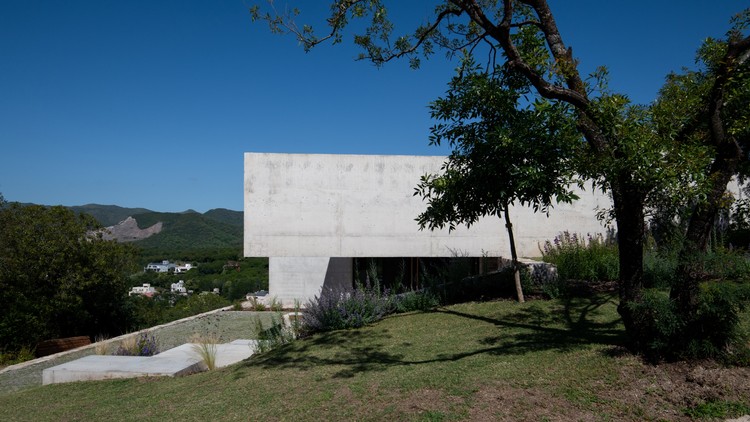Home Kisito Albert Faus
2016-08-31 05:00
© Giovanni Quattrocolo
(Giovanni Quattrocolo)


架构师提供的文本描述。Kisito之家为0-24个月的婴儿提供住宿托儿服务。近年来,一些儿童出现了脑病所致的残疾,这就是为什么到目前为止找不到寄养家庭的原因。该孤儿院永久处于其容纳能力的极限,这迫使婴儿和残疾婴儿共用休息场所。正如负责人所解释的那样,这种做法使该中心出现故障,因为儿童需要特殊和差别待遇。
Text description provided by the architects. HOME KISITO is a Residential Childcare for babies 0-24 months. Recent years some children have come presenting disabilities result of encephalopathy, which is why it has been impossible to find a host family until now. The orphanage is permanently at the limit of its capacity which forces babies and infants with disabilities to share resting place. As the responsible explained, this practice makes the center incurs malfunction because children need a specialized and differential treatment.
© Giovanni Quattrocolo
(Giovanni Quattrocolo)


2012年夏天,四名年轻妇女在孤儿院接待了一名志愿者。与这些动物及其看护者的日子,以及与该中心宗教领袖的讨论,导致他们提议为有特殊需要的儿童建造这所房子。
In the summer of 2012 four young women held a volunteer at the orphanage. The day with the creatures and their carers and the discussions with the religious head of the center led them to propose the construction of the house for children with specific needs of HOME KISITO.




旧楼由一座中央结构和位于地块东侧的两卷书组成。新的建筑在剩余的空旷空间上占据了一个实质的中心位置,与孤儿院主建筑的正面平行,并且沿着一个由代表高水箱的强大的视觉参考所定义的轴线。由此产生的两个建筑物之间的区域成为中心的入口广场,接待处和未来的操场在芒果树的树荫下。
The pre-existing building consists of a central structure and two other volumes located in the eastern third of the plot. The new construction takes a substantially centered position on the empty space remaining, parallel to the facade of the main edifice of the orphanage, and along an axis defined by the powerful visual reference that represents the high water tank. The resulting area between the two buildings becomes the entrance square to the center, site for receptions and future playground in the shade of the mango trees.
© Giovanni Quattrocolo
(Giovanni Quattrocolo)


© Giovanni Quattrocolo
(Giovanni Quattrocolo)


该方案是根据首席修女的要求和估计捐款的愿望确定的。它包括一个外地通道,一个治疗,一个服务区和住宿区。
The program was defined based on the demands of the Principal Sister and with the estimating donations aspired to achieve. It consists of a field access, a treatment, a block of services and accommodation wing.
© Albert Faus
C.阿尔伯特·福斯


© Albert Faus
C.阿尔伯特·福斯


该建筑的设计和施工试图缓解当地气候的限制,如长期的高平均气温、低相对湿度和夏季伴随着强东风的降雨。在主立面的东面是一堵厚厚的石墙,它起到保护风暴的作用,双面屋顶的顶部比建筑物的高度高约2.5米,同时形成了一个阴凉的外围,降低了附近的室外温度。不同的常绿树线垂直于盛行的微风(从东到西)的方向,这种风除了使空气增湿外,还能保护人们免受下午的阳光(艳丽)的影响,把树的高度降低到与儿童(腰果)更接近的程度,并提供丰富的水果(芒果)。
The design and construction of the building attempt to alleviate the constraints of the local climate, such the long periods of high average temperatures with low relative humidity and the rain accompanied by strong easterly winds in summer. To the east of the main façade is a thick stone wall, which acts as a protective screen for the storms and the uppermost of the twin roofs exceeds the height of the building by some 2.5m, creating at the same time a shady perimeter and lowering the nearby outside temperature. Different lines of evergreen trees are planted perpendicular to the direction of the prevailing breezes (east to west), which, in addition to humidifying the air, provide protection from the afternoon sun (flamboyant), reduce the height to a scale more in line with the kiddies (cashew) and provide an abundance of fruit (mango).


由于压缩的土墙、拱形的天花板和地板,建筑物的内部保持了凉爽。墙面上的彩色“昆虫屏风”使前厅被配置成一个受保护的、永久通风的内部通道,允许交叉通风并释放出温暖的上升空气。这种影响在这条走廊的相对两端(南北)、梯田水平(东西)以及垂直平面上的开口更加突出,中央拱顶的BTC被金属框架上的昆虫屏所取代。
The interior of the building is kept cool thanks to the compressed earth walls, vaulted ceilings and flooring. The coloured “insect screens” on the façades allow the vestibule to be configured as a protected, permanently ventilated internal passageway, permitting cross ventilation and emitting warm rising air. This effect is accentuated with the openings at the opposing ends of this corridor (north-south) and at the level of the terraces (east-west), as well as in the vertical plane, with the interruption of BTC in the central vaults being replaced by an insect screen on metal frame.
这项工作是在一个“合唱”过程中进行的,在每一阶段以尽可能低的成本寻找最佳的行动者。考虑到项目的社会性质,一家同意降低利润率的公司获得了挖掘和具体要素。这些墙是由年轻的受训人员建造的,天花板是由经验丰富的船员建造的。石工和金属结构被委托给已经在以前的项目中工作过的团队,例如一群妇女,她们用手将内部的石头用粘土抹灰。最后,我们采用当地的技术,用彩色塑料网编织椅子和躺椅,以获得正面和走廊的“蚊帐”,并与盲人和部分视力低下的人一起工作。
The work has been carried out in a “choral” process, seeking the optimal actor at the lowest possible cost in each phase. The excavation and concrete elements were awarded to a company which agreed to reduce profit margins, taking the social nature of the project into account. The walls were built by young trainees and the ceilings by a highly experienced crew. The stonework and metallic structure was entrusted to teams who had already worked on previous projects, such as the group of women who rendered the interior stone facing by hand with clay plastering. And finally, we adapted the local technique to make chairs and loungers weaving with colored plastic mesh to get the “mosquito nets” of facades and corridor, working with an association of blind and partially sighted people.
© Giovanni Quattrocolo
(Giovanni Quattrocolo)












































.jpg)







Architects Albert Faus
Location Ouagadougou, Burkina Faso
Category Houses
Collaborators Ferran Grau, Miquel Feliu, Miquel Comadran, Octave Petit
Client Nasaras by Home KisitoArea Association
Area 235.0 sqm
Year of project 2015
Photographs Giovanni Quattrocolo, Albert Faus
Manufacturers Loading...































